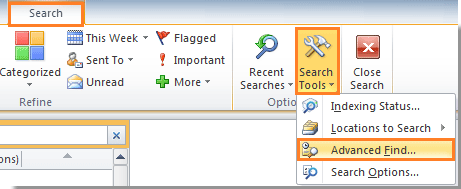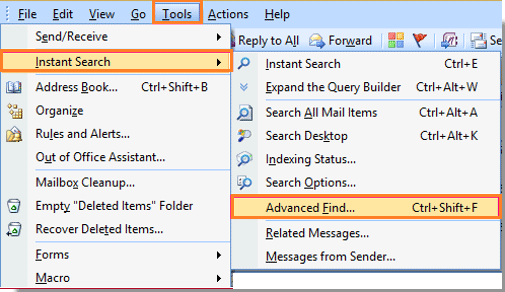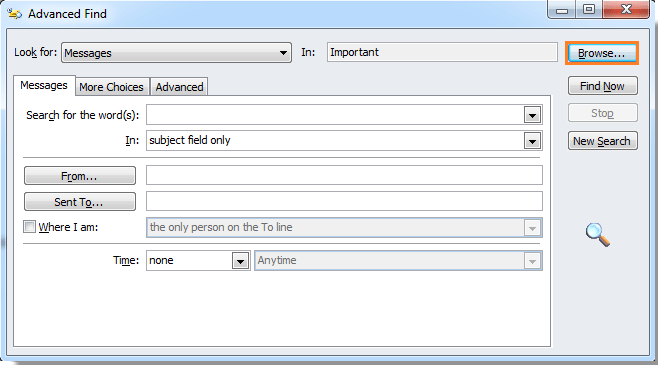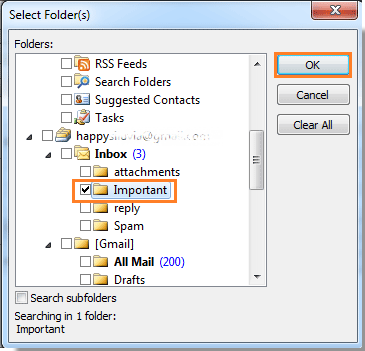Como mostrar o caminho completo da pasta dos resultados de pesquisa de e-mails no Outlook?
Você já se sentiu frustrado porque o Outlook só mostra a pasta que contém os resultados de pesquisa correspondentes? Se houver pastas com nomes iguais no seu Outlook, pode ser muito demorado encontrar a pasta específica uma por uma para determinado resultado de pesquisa. Mostrar o caminho completo da pasta do resultado da pesquisa de e-mail é uma maneira eficiente de encontrar a pasta certa dos e-mails localizados na pesquisa. Por favor, consulte o artigo a seguir para obter mais informações detalhadas.
Mostrar o caminho completo da pasta dos resultados de pesquisa de e-mails no Outlook
Mostrar o caminho completo da pasta dos resultados de pesquisa de e-mails no Outlook
Para encontrar o caminho completo da pasta de um e-mail na lista de resultados de pesquisa no Outlook, siga os passos abaixo.
1. Após concluir a pesquisa de e-mails, selecione um e-mail para o qual deseja mostrar o caminho completo da pasta.
2. Em seguida, clique em Pesquisar > Ferramentas de Pesquisa > Pesquisa Avançada no Outlook 2010/2013/2016, ou você pode pressionar as teclas de atalho Ctrl + Shift + F para ativar a função Localizar e Substituir.

Dica: No Outlook 2007, clique em Ferramentas > Pesquisa Instantânea > Pesquisa Avançada para abrir a caixa de diálogo Localizar e Substituir, veja a captura de tela:

3. Na caixa de diálogo Pesquisa Avançada que aparece, clique no botão Selecionar.

4. Após clicar Selecionar botão na Pesquisa Avançada caixa de diálogo, uma Selecionar Pasta(s) caixa de diálogo será exibida. Nesta caixa de diálogo, você poderá ver a pasta específica do e-mail selecionado que está marcada com uma ![]() marca.
marca.

Com este método, você pode ver o caminho completo da pasta do resultado da pesquisa à primeira vista e ir diretamente para a pasta desejada para encontrar facilmente o e-mail que você pesquisou.
Salvar ou Exportar Múltiplos E-mails para Outros Formatos de Arquivos (PDF/HTML/WORD/EXCEL) no Outlook |
| Às vezes, você pode querer salvar ou exportar os e-mails para uma pasta em outros formatos de arquivos, como PDF, Word ou Excel no Outlook. No Outlook, nem a função Salvar como nem a função Exportar conseguem lidar com essa tarefa. No entanto, o utilitário Salvar como arquivo do Kutools para Outlook pode exportar vários e-mails para uma pasta como arquivos em múltiplos formatos de uma só vez. Clique para experimentar gratuitamente por 45 dias! |
 |
| Kutools para Outlook: com dezenas de complementos úteis para o Outlook, grátis para experimentar sem limitação por 45 dias. |
Melhores Ferramentas de Produtividade para Office
Notícia de Última Hora: Kutools para Outlook Lança Versão Gratuita!
Experimente o novo Kutools para Outlook com mais de100 recursos incríveis! Clique para baixar agora!
📧 Automação de E-mail: Resposta automática (Disponível para POP e IMAP) / Agendar Enviar Email / CC/BCC automático por Regra ao Enviar Email / Encaminhamento automático (Regra avançada) / Adicionar Saudação automaticamente / Dividir automaticamente Emails com múltiplos destinatários em Email individuais ...
📨 Gerenciamento de Email: Recallar Email / Bloquear emails fraudulentos por Assunto e outros critérios / Excluir Duplicado / Pesquisa Avançada / Organizar Pastas ...
📁 Anexos Pro: Salvar em Lote / Desanexar em Lote / Comprimir em Lote / Salvar automaticamente / Desanexar automaticamente / Auto Comprimir ...
🌟 Magia da Interface: 😊Mais emojis bonitos e legais / Notificações de emails importantes / Minimizar Outlook em vez de fechar ...
👍 Recursos de um clique: Responder a Todos com Anexos / Emails Anti-Phishing / 🕘Exibir o fuso horário do remetente ...
👩🏼🤝👩🏻 Contatos e Calendário: Adicionar contato em lote dos Email selecionados / Dividir um Grupo de Contatos em grupos individuais / Remover lembrete de aniversário ...
Utilize o Kutools no idioma que preferir — disponível em Inglês, Espanhol, Alemão, Francês, Chinês e mais de40 outros!


🚀 Download com um clique — Baixe todos os complementos de Office
Recomendado fortemente: Kutools para Office (5 em1)
Um clique para baixar cinco instaladores de uma vez — Kutools para Excel, Outlook, Word, PowerPoint e Office Tab Pro. Clique para baixar agora!
- ✅ Comodidade em um clique: Baixe todos os cinco pacotes de instalação em uma única ação.
- 🚀 Pronto para qualquer tarefa no Office: Instale os complementos que você precisa, quando precisar.
- 🧰 Inclui: Kutools para Excel / Kutools para Outlook / Kutools para Word / Office Tab Pro / Kutools para PowerPoint